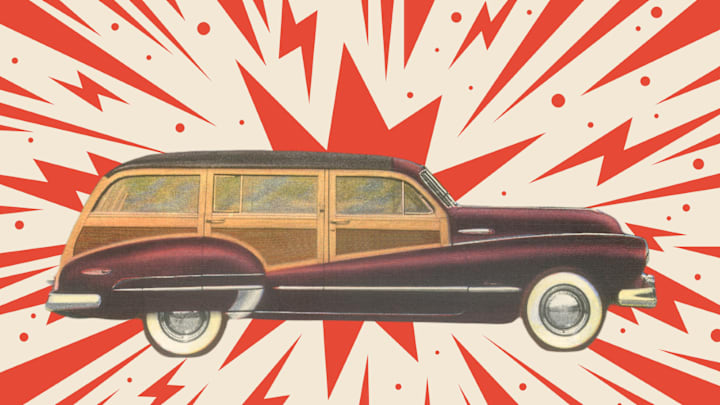Not even Clark Griswold takes as much abuse en route to Walley World as the “Wagon Queen,” the station wagon carrying his family from Chicago to California in 1983’s National Lampoon’s Vacation. With its pea green chassis and wood paneling, the Queen was so viscerally revolting that the movie is credited with ushering in—or at least symbolizing—the demise of the all-family vehicle.
But for over a decade, these clunky automobiles were a common sight on highways. And many of them sported a now-inexplicable feature: faux wood grain exterior paneling. Cars that looked like stereo speakers on wheels were the aesthetic choice for many, and the mere mention of them evokes visions of a dashboard crammed with 8-track tapes and cigarette lighters.
They even earned an appropriately kitschy nickname: “woody wagons.”
Side Swiped
It’s hard to pinpoint the exact origins of wood panel couture. According to Apartment Therapy, wooden wall panels in architecture date back to Elizabethan and Tudor-style design. Sometimes it was utilitarian—wood was better for insulating a house—and other times it was ornamental. After World War II, the explosion of home construction meant finding cheap ways to make interiors feel warmer. Wood and wood paneling was key.

People looked for that same vibe in their automobiles, too. When car production began ramping up in the 1920s, it wasn’t unusual for manufacturers to use wood for the entire body of the vehicle. Horse-drawn carriages, boats, and planes were, after all, made of wood, and steelmaking was expensive. Some enterprising types added aftermarket wooden panels to give a car a more distinguished appearance. It was a status symbol, as the constant upkeep required for wood—weather-sealing, varnishing, polishing—was an expensive endeavor.
Automaker Henry Ford was a proponent of the approach. His Ford company bought 400,000 acres of forest in Michigan so wood for auto bodies could be harvested. In 1929, Ford introduced the first mass-produced “woody,” a $695 bargain (about $12,000 in today’s dollars) made of maple, birch, and mahogany and with a single piece of glass for the front windshield. Side windows were just open spaces with curtains.
Ford marketed it as a commercial truck. That’s because vehicles with more cabin space were growing in popularity. The term station wagons grew out of vehicles that were used to pick people up from train stations, hauling their belongings to vacation destinations.
But by the late 1940s, producing “woodies” was no longer cost-effective. The cars had to be made by hand, and an artisanal approach to mass production was financially impossible. To get the look, carmakers opted to use a more durable chassis like steel and then apply wood paneling for the exterior. (The Chrysler Town and Country was among the popular models of the era.)
Expert Panel
Just when it seemed like the trend was due to expire, along came surfers. Beach bums of California found that used wood and wood-paneled cars held up better on the west coast thanks to its lack of snow; the ample storage of station wagons in particular gave them plenty of room for their surfboards.

Wood was still desirable, but its lack of durability was a problem. (Try getting into a highway accident in a car made of birch.) In the 1970s, technological developments made the fabrication of faux wood grain paneling feasible and cheap. These pieces could be synthetic, but have the appearance of oak or cedar. That meant one could easily accessorize their home in faux wood, with everything from stereo equipment to your Atari video game console sporting the look. It also meant cars could be decked out in water- and wear-resistant wood finishes. In some cases, the “wood” was just a vinyl decal applied to the body.
While station wagons remained the premier canvas for wood paneling—more that 1 million of the vehicles were sold for three consecutive years in 1971, 1972, and 1973—wood grain eventually moved to other car types. Some models, like the Pontiac Acadian, had a faux wood finish as an option, meaning someone would have to willingly pay extra for the privilege. Others, like the AMC Pacer, virtually forced drivers to accept it.
It wasn’t necessarily that wood paneling died out. It was that the station wagon collapsed and took out everything associated with it. The wagon’s demise correlated with the surge of interest in the minivan, a more nimble family vehicle first introduced in 1984 by Chrysler. Minivans were also more fuel efficient, which was a key benefit after the oil crisis that consumed part of the ‘70s.
While the woody may have gone off-road, it hasn’t been forgotten. Classic car collectors value their craftsmanship, and finding one in good condition—without the expected rot—can mean a six-figure sum being fetched at auction. Maybe Clark Griswold should have kept his.
